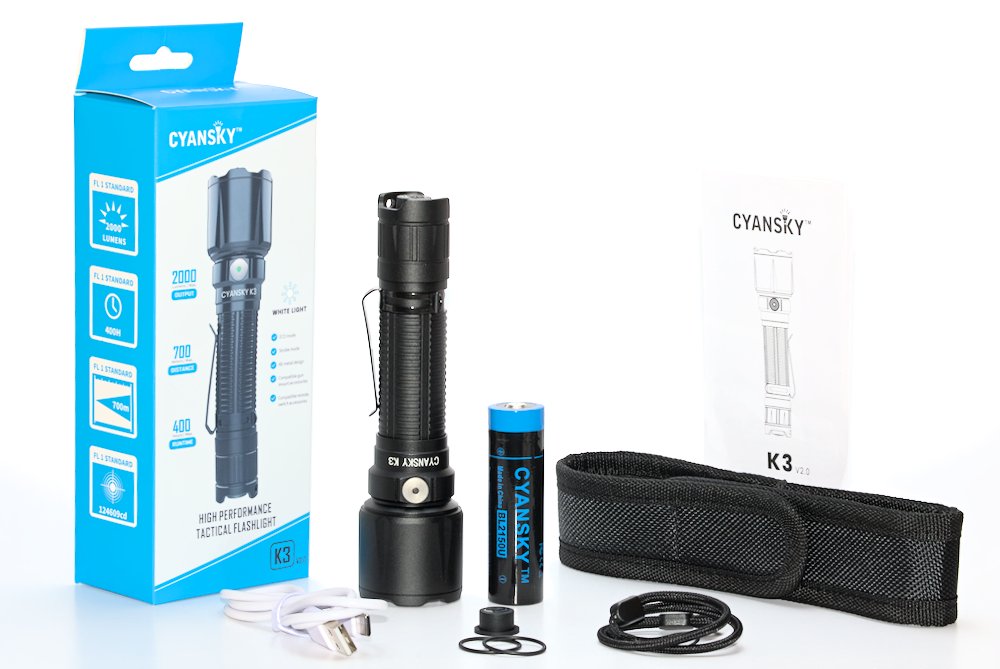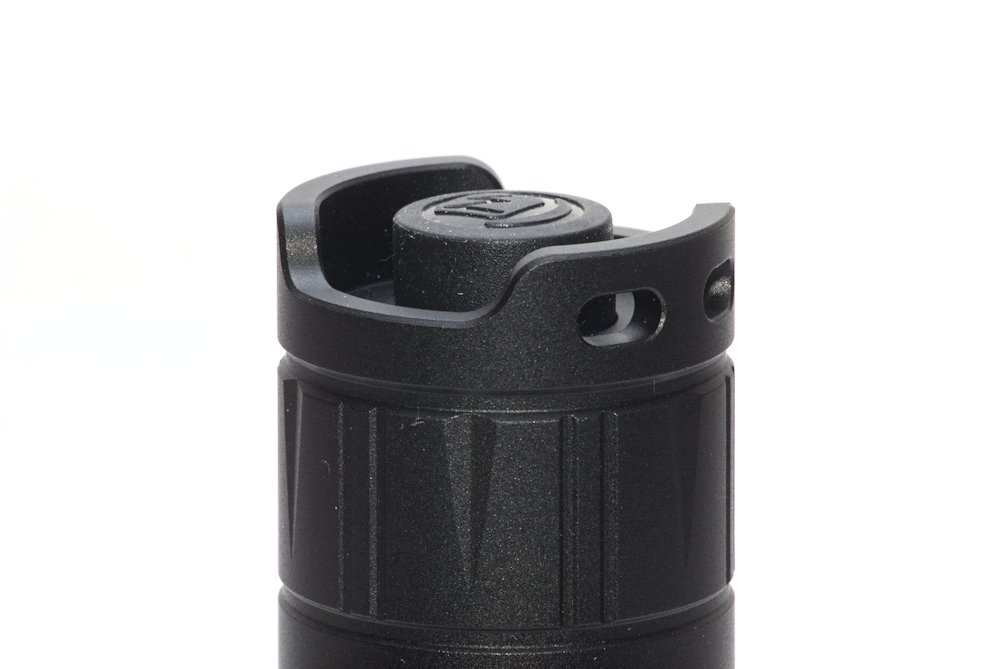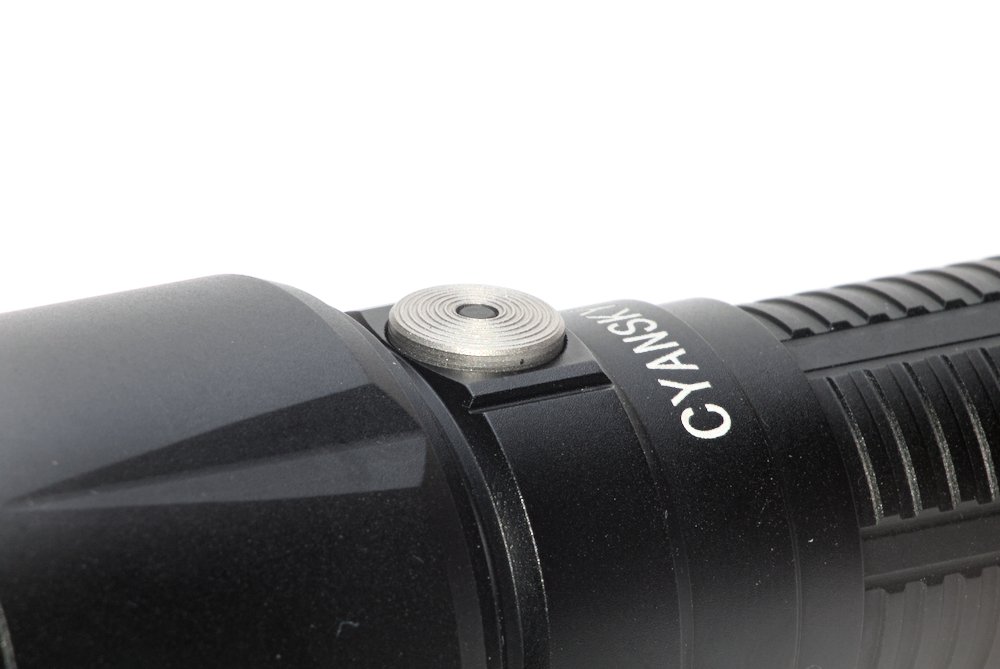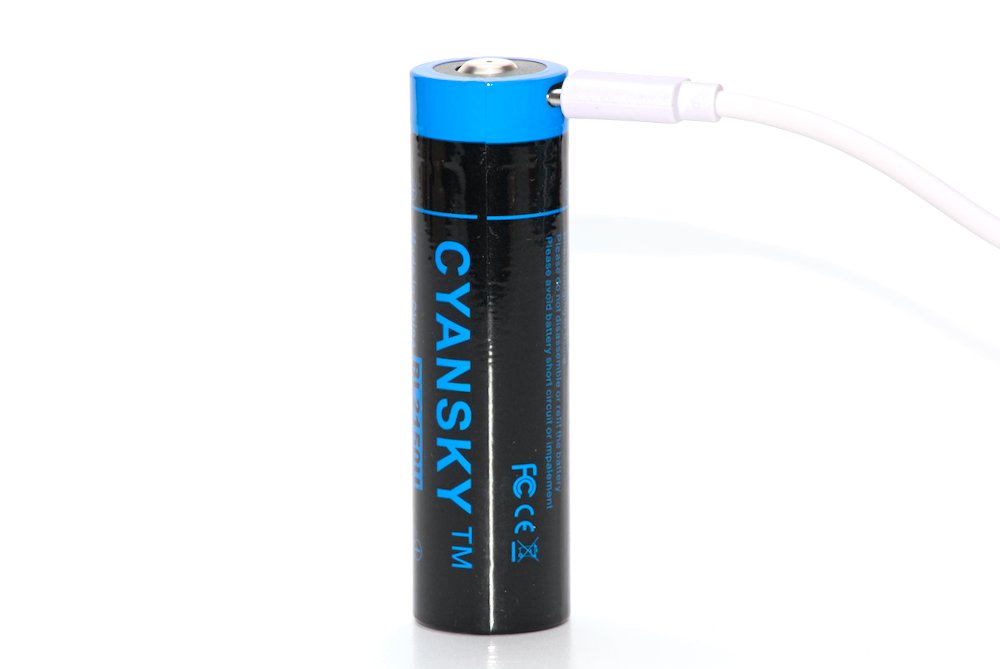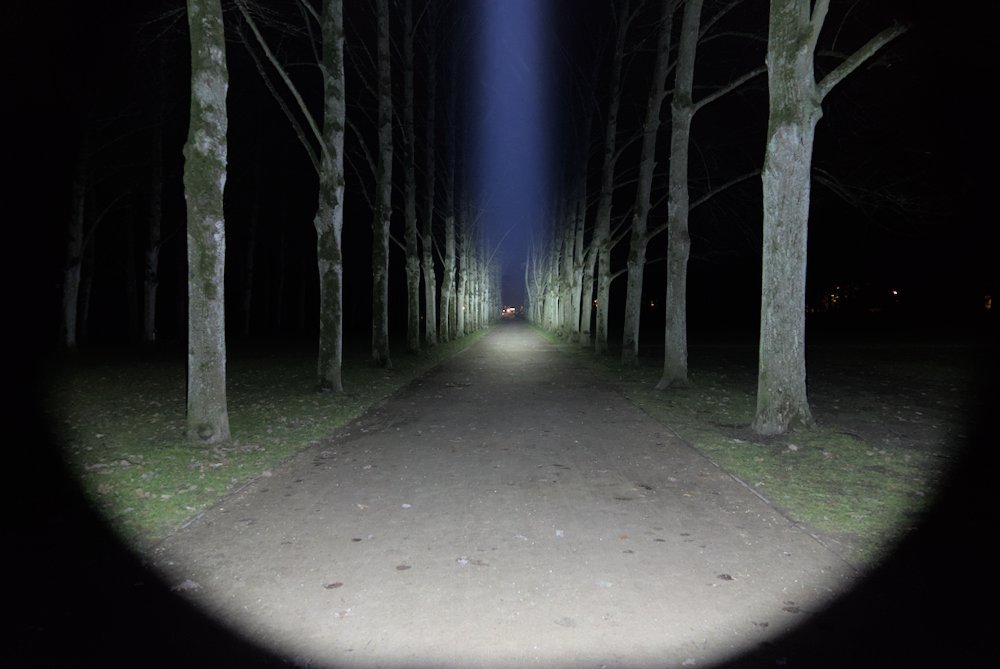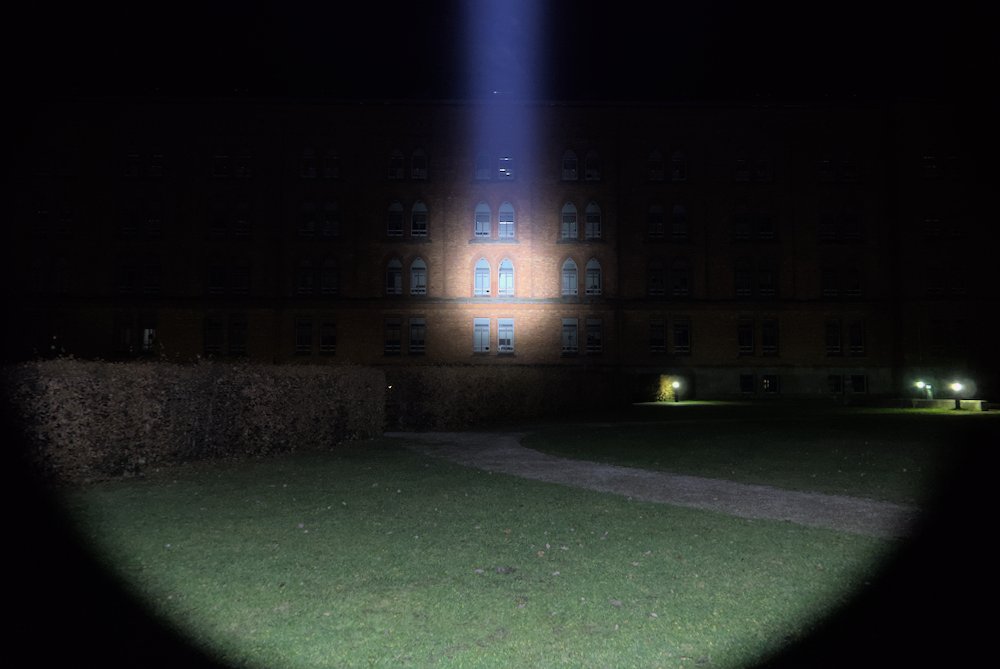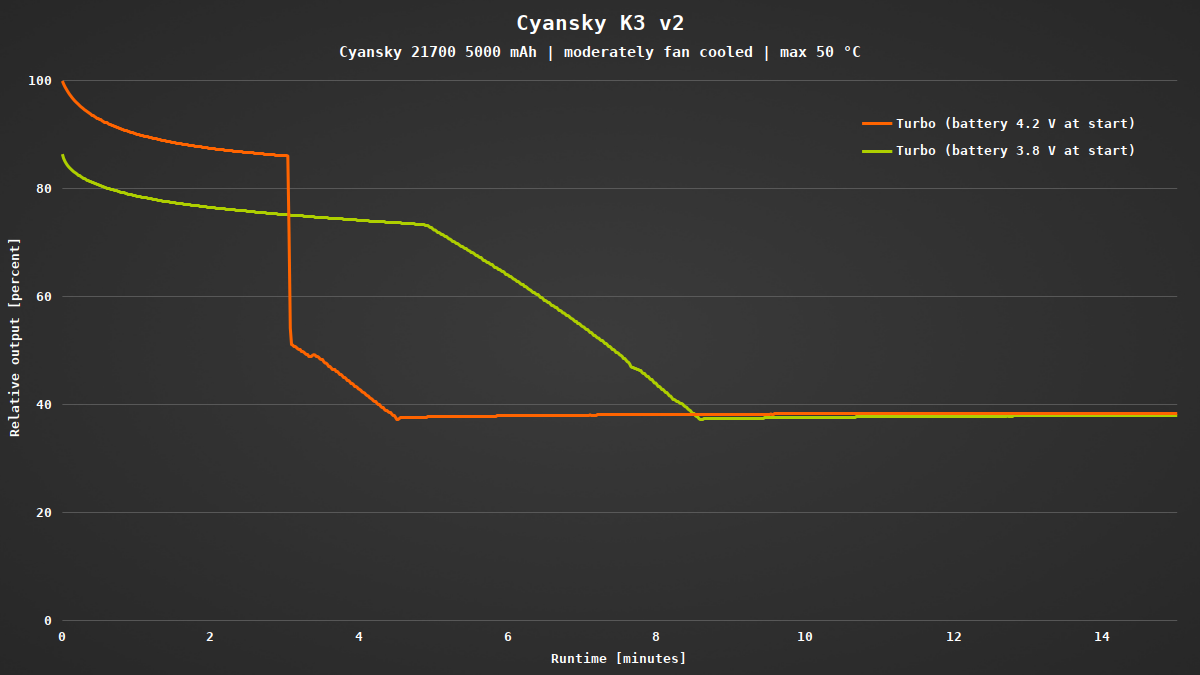Recently I was lucky enough to win a Cyansky K3 v2 in a giveaway. Here are my first impressions of the flashlight. Thanks to Cyansky for the giveaway!
This review is also available in German on my website
Supplied parts and hardware
- 21700 Li-ion battery with 5000 mAh (3.8 V on delivery, button-top, protected, 76 mm long, integrated USB-C charging)
- Clip (already attached)
- Lanyard
- Holster
- USB-C cable
- Replacement O-ring (2x)
- Replacement tail switch cover (1x)
- Manual (EN, CN)
The manual is mostly a datasheet describing the properties of the flashlight in detail because the UI is very simple.
For a tactical flashlight small size and low weight are less important than robustness and handling.
Length: 154 mm
Diameter: 40 mm (head) / 25.5 mm (battery tube)
Weight: 133 g (+ 72 g for the battery)
The tactical feeling starts with the head: The crenelated bezel (smooth and rounded) includes three tiny spheres (claimed to be made of zirconium) as a glass breaker. The spheres make the flashlight slightly wobbly when head standing.
The flashlight has two switches: One mechanical tail switch for the switching the light on and off. There are also two holes to attach a lanyard. Two holes make it possible that the tailstand is not affected by the lanyard.
Then there’s an electronic side switch at the head to change the brightness. It includes a status LED.
No integrated charging in the flashlight itself. A charging port is always a weak spot – something you might not want in a tactical flashlight.
But the included battery has integrated USB-C charging. So you don’t need a separate charger and you can quickly replace the battery with a spare one while the first one charges.
A status LED integrated in the positive pole indicates the charging status (red/green). Charging is very slow with only 1.5 A and it takes about four hours to charge the battery.
There are long springs at the head and the tail. This allows for a wide range of batteries. Protected and unprotected, flat and button top, 21700, 18650. Per manual even 2*16340 or 2*CR123A (and thus probably also 2*18350).
To carry the flashlight you can either use the clip or the included holster. It has a fixed loop to attach it to a belt and is closed via velcro.
Build quality is perfect! No sharp edges, grippy texture on the battery tube and the matt black anodization (type III per manual) appears to be very robust (no scratches after removing the pocket clip multiple times).
User interface and features
It’s simple: Tail switch to turn the flashlight on and off (forward clicky with momentary). Side switch to change the brightness.
To reach the lowest “Eco” mode you keep the side switch pressed while turning on the flashlight. Unfortunately there is no direct access to turbo and strobe is only available when the flashlight is already on.
|
State |
Action |
Function |
|---|---|---|
|
Off |
Tail switch half |
Momentary of last used brightness from Low/Medium/High/Turbo |
|
Off |
Tail switch full |
Turn on (last used brightness from Low/Medium/High/Turbo) |
|
Off |
Hold side switch |
Eco |
|
On |
Tail switch full |
Turn off |
|
On |
Click side switch |
Change brightness (Low → Medium → High → Turbo) |
|
On |
Hold side switch |
Strobe |
The tail switch has long travel and precise actuation. The cover is a little thin and you can feel the actual switch in the middle.
The momentary function of the forward clicky allows you to blink with the flashlight. But there is a 175 ms delay between pressing the switch until the light turns on. This makes short blinks difficult.
The side switch has also very good actuation. It has a grippy texture and is slightly protruding. No problem regarding pocket activation because it only works when the light is turned on with the tail switch. It can be found by feel, but you might have to turn the flashlight one rotation.
The switch includes a status LED that shows the approximate state of charge of the battery for three seconds after the light was turned on:
|
Color |
State of charge |
|---|---|
|
Green |
75% – 100% |
|
Green blinking |
50% – 75% |
|
Red |
25% – 50% |
|
Red blinking |
< 25% |
The concept of using a tail switch to turn the light on and off and a side switch to change the brightness is very common, but has some downsides because you have to change your grip between the two switches. Having both switches together makes the manufacturing much more difficult, though.
Illumination
A Luminus SFT-40 with 6500 K in a smooth 30 mm reflector. Sounds like nothing special, but Cyansky brought it to perfection.
The beam is beautiful! Small, round spot and a uniform spill. No artifacts or rings, no tint shift. The LED is not perfectly centered, but no big deal. The crenelation is wider at the points with the spheres which creates three flat sides in the spill.
Driver and runtime
A buck driver in the K3 maintains a mostly constant brightness and allows a wide range of input voltage.
¹ According to manufacturer ² ANSI FL1 ³ Measured
|
Mode |
Brightness¹ |
Runtime¹ |
Intensity¹ (throw²) |
Current³ |
|---|---|---|---|---|
|
Turbo |
2000 lm |
2 h |
124 609 cd (700 m) |
7.350 A |
|
High |
450 lm |
4.5 h |
28 561 cd (336 m) |
0.950 A |
|
Medium |
150 lm |
16 h |
9 802 cd (200 m) |
0.315 A |
|
Low |
30 lm |
66 h |
441 cd (42 m) |
0.075 A |
|
Eco |
2 lm |
400 h |
0,25 cd (1 m) |
0.018 A |
The manual even includes a runtime diagram! You don’t see that often.
It mostly matches my measurements. Once the flashlight reaches 50 °C the brightness is reduced. In turbo that happens after about 3-5 minutes, depending on the battery voltage. Afterwards the temperature stabilized at ca. 35 °C.
At 3.0 V the indicator LED starts to blink red and the main LED blinks every three minutes. There is no low voltage protection, the flashlight runs until the battery is completely drained or the battery protection kicks in.
With a half full battery the turbo brightness is slightly lower, but it runs longer (50 °C is reached later).
There’s no PWM, only minimal ripple (not visible). Due to the mechanical side switch it doesn’t need any current at all when it is off. You can also loosen the tailcap for a mechanical lockout.
Conclusion
The Cyansky K3 v2 convinces with its simple operation and in particular with the very clean beam with a decent range. The regulation of the driver is also quite good.
Direct access to the turbo would be nice. To change the brightness, you have to reach for the side button, sometimes a bit annoying.

